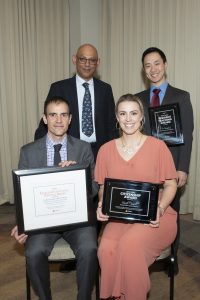The Professional Association of Residents of Ontario (PARO) honoured NOSM faculty and learners at the 2019 PARO Awards Dinner on May 3, 2019, in Toronto. Congratulations to Dr. Frédéric Sarrazin, NOSM Family Medicine Enhanced Skills Program Director faculty and member, Dr. Vincent Le, NOSM resident, and Ms. Sarah Cannell, NOSM medical student.
Award Details:
Dr. Frédéric Sarrazin – 2019 Excellence in Clinical Teaching Award Recipient
NOSM Faculty – Department of Family Medicine, NOSM Family Medicine Enhanced Skills Program Director
The Clinical Teaching Awards acknowledge the essential role that good clinical teachers play in the training of physicians. Residents are asked to outline the qualities that make their nominee an excellent teacher including patient care, quality of bedside teaching, and interest in the trainees’ personal development and well-being.
Dr. Vincent Le – 2019 Resident Teaching Award Recipient
NOSM Resident – PGY2 Internal Medicine
The Resident Teaching Awards honour residents who have provided outstanding clinical teaching experiences to junior house staff and clinical clerks.
Ms. Sarah Cannell – 2019 Citizenship Award Recipient
NOSM Medical Student, Phase 2
The Citizenship Awards recognize medical students who, in addition to maintaining an adequate academic standing, have made a significant contribution towards improving the general welfare of fellow medical students.
Please refer to the 2019 PARO Award Recipients announcement for a full list of all award recipients.



